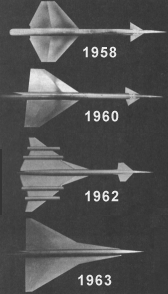Lockheed L-2000
|
|
The Lockheed L-2000 was Lockheed's entry into the contest to build the United States' first supersonic transport (SST). The L-2000 lost the contest to the Boeing 2707, but in the end neither was built due to increasing public anger over sonic booms.
In 1961, President John F. Kennedy committed the government to subsidizing the development of a commercial airliner to compete with the Concorde. The director of the Federal Aviation Administration, Najeeb Halaby, decided that the Concorde was too far ahead in development to bother building a direct competitor, and instead selected a much more advanced standard as their baseline. The SST was intended to carry 250 passengers (a large number at the time), fly at Mach 2.7-3.0, and have a range of 4,000 miles. The program was launched on June 5, 1963, and the FAA estimated that by 1990 there would be a market for 500 SST's. Boeing, Lockheed, Douglas, Republic and North American officially responded, and eventually the Boeing and Lockheed designs were selected for further study.
 |
| Lockheed SST design evolution |
Lockheed had done a number of "paper studies" on various SST designs since the 1950s. Early designs followed Lockheed's unique high-speed design, which used a short almost rectangular wing, as opposed to the swept wings or delta wings favoured by most other designers. This design can be see on the F-104 Starfighter for instance, and was intended to be used on a number of other projects as well.
Starting with the SR-71, however, Lockheed started moving towards deltas. Their SST designs followed suit, leading to the delta winged L-2000 series. A number of similar designs were studied at a range of sizes and passenger capacities, from the 170-seat 2000-1, to the 250 seat -3 and -7's. All of these designs used a 2 by 3 seating arrangement, slimmer than the more common 3 by 3 found on other "narrow body" airliners of the era.
During the period between 1963 and 1966, when the proposals were returned to the FAA, the design took on its final form as the L-2000-7B. It was, for all intents, a larger version of the Concorde. The differences tended to be in the details, Lockheed used a simpler compound-delta planform instead of the Concorde's more complex ogive, and the Pratt & Whitney JTF17 engines were mounted in individual cylindrical nacelles with a vertical splitter into the shock ramps, instead of the Concorde's box-like nacelles with horizontal intake ramps. The L-2000 also had a prominent "belly" for fuel and cargo, with the main fuselage sitting somewhat higher over the wing than on other designs.
| Missing image Lockheed_L-2000_three_view.jpg Image:Lockheed_L-2000_three_view.jpg |
| Lockheed L-2000-7 three-view |
On December 31, 1966 full-scale mockups of the Boeing 2707-200 and L-2000-7 design were presented, and the Boeing design was selected. The L-2000 was judged simpler to produce and less risky, but its performance was slightly lower and its noise levels slightly higher. Given the mandate to design a plane that was technically more advanced that the Concorde, the choice does make some sense. As history would later prove, the complex 2707 would run into serious problems.
|
Lists of Aircraft | Aircraft manufacturers | Aircraft engines | Aircraft engine manufacturers Airports | Airlines | Air forces | Aircraft weapons | Missiles | Timeline of aviation |
